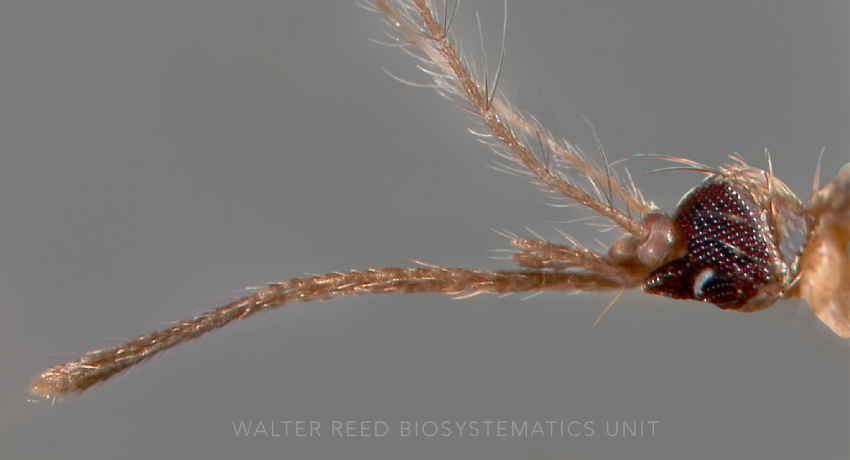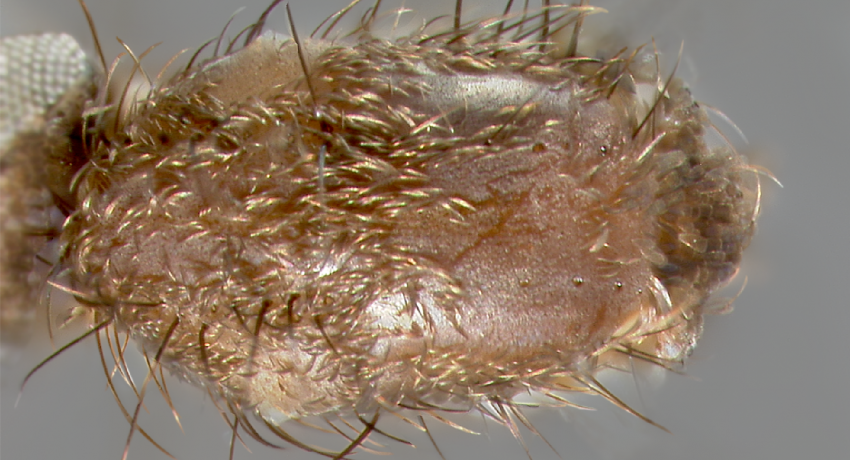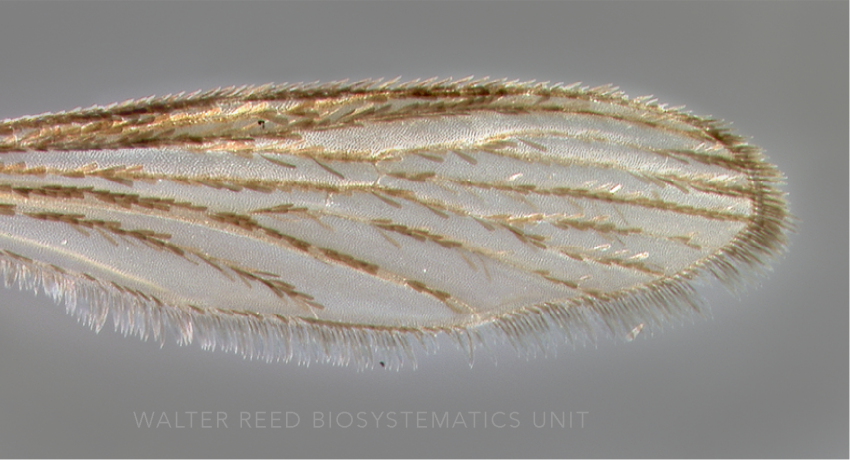NEOTROPICAL REGION
Generic abbreviation: Ga.
Type species: Galindomyia leei Stone & Barreto
Etymology: Pedro Galindo
The monotypic genus Galindomyia is one of four genera represented in the tribe Culicini. Galindomyia leei Stone & Barreto shares morphological similarities with Culex and Deinocerites species. Like Deinocerites species and different from Culex species, Galindomyia leei has short palps, with antenna much longer than the proboscis. The swollen proboscis tip (evident in both sexes) differentiates Galindomyia leei from Deinocerites species.
DIAGNOSTIC CHARACTERS (Click photos to view; mouse over and click large photo to zoom in.)
ADULT (illustrated): Head: Antenna longer than proboscis; vertex with broad decumbant scales, with a few erect head scales on occiput; eyes contiguous; flagellomeres Flm1 and Flm13 very long, about equal length. Thorax: Prespiracular and postspiracular setae absent; acrostichal setae absent; paratergite bare; mesepimeron with a patch of upper setae and a single lower seta. Wing: Vein 1A ends beyond mediocubital crossvein; vein R2 distinctly longer than vein R2+3; membrane with distinct microtrichiae. Leg: Pulvilli present.
LARVA (not illustrated): Head: Occipital foramen circular, collar incompletely developed; setae 2,3-C absent. Abdomen: Seta 1-VI medial of 2-VI. Terminal segments: Comb with comb scales in a triangular patch; pecten with pecten spines extending to mid-siphon; saddle not well demarcated, with poorly sclerotized dorsal and ventral plates; seta 1-S with 3 pairs of setae, 2 large and 1 small; seta 4-X with 5 pairs of setae on a grid.
TAXONOMIC KEYS
None
![]()
WRBU – Genera – Global – Larva
![]()
WRBU – Genera – Neotropical – Adult
![]()
WRBU – Genera – Neotropical – Larva
Exemplar DNA sequences
None
BIONOMICS
Immatures
Females lay their eggs just above the waterline in humid crabholes and neonates drop or slide down into the aquatic habitat below. Unlike in floodwater mosquitoes, it appears that water inundation is not needed to stimulate egg hatching.
Adults
Female Galindomyia leei were first discovered in Curico, Colombia, resting in crabholes in mangrove swamps where the Rio Raposo meets the Pacific Coast. Males were collected in light traps in Ecuador.
*Associated pathogens: This list reports bacteria, viruses, and parasites recovered from, or experimentally passed through this species, and does not imply field vector status.
IMPORTANT REFERENCES (full citations below)
Stone & Barreto 1969: 143 (M*, F*)
Adames 1971 (phylogeny)
Harbach & Kitching 1998 (phylogeny)
Harbach et al. 2012 (phylogeny)
VALID SUBGENERA
None
CURRENT GENERIC SYNONYMS
None
CITED REFERENCES
Adames, A.J. (1971). Mosquito studies (Diptera, Culicidae). XXIV. A revision of the crabhole mosquitoes of the genus Deinocerites. Contributions of the American Entomological Institute, 7(2), 1–154.
Harbach, R.E. & Kitching, I.J. (1998). Phylogeny and classification of the Culicidae (Diptera). Systematic Entomology, 23(4), 327–370.
Harbach, R.E., Kitching, I.J., Culverwell, C.L., Dubois, J., & Linton, Y.-M. (2012). Phylogeny of mosquitoes of tribe Culicini (Diptera: Culicidae) based on morphological diversity. Zoologica Scripta, 41(5), 499–514.
Stone, A., & Barreto, P. (1969). A new genus and species of mosquito from Colombia, Galindomyia leei (Diptera, Culicidae, Culicini). Journal of Medical Entomology, 6, 143–146.
CITE THIS PAGE
Walter Reed Biosystematics Unit (Year). Galindomyia genus page. Walter Reed Biosystematics Unit Website, http://wrbu.si.edu/vectorspecies/genera/galindomyia, accessed on [date (e.g. 03 February 2020) when you last viewed the site].







